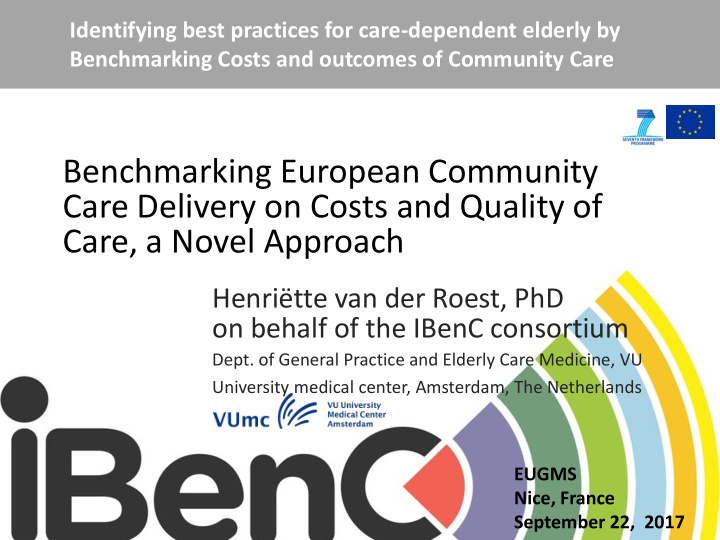



Identifying best practices for care-dependent elderly by Benchmarking Costs and outcomes of Community Care Benchmarking European Community Care Delivery on Costs and Quality of Care, a Novel Approach Henriëtte van der Roest, PhD on behalf of the IBenC consortium Dept. of General Practice and Elderly Care Medicine, VU University medical center, Amsterdam, The Netherlands EUGMS Nice, France September 22, 2017
Conflict of interest disclosure I have no potential conflict of interest to report
The consortium Project information Programme: FP7-HEALTH-2012-INNOVATION-1 Start Date: January 1, 2013 End Date: December 31, 2016 Coordinator: VU University Medical Center Grant agreement no.: 305912 EU Contribution: € 2,999,198.00 Project Coordinator: VU University Medical Center
Ageing in Europe Source: Eurostat 2017
Best practices Efficient care systems are key Driven by best practices, delivering – good quality care – against reasonable costs Identification only trough appropriate benchmark open to multiple organisations → Currently focus mainly on quality → Costs often neglected Insight creates learning potential
Aim IBenC projects’ aim: To identify best practices of community care delivery for care dependent community dwelling elderly → Develop a benchmark methodology based on quality and costs of care utilisation → Characterise best practices
IBenC study sample n c = 456 n c = 420 n o = 3 n o = 1 38 n c = 491 n o = 3 n c = 493 n o = 11 2884 n c = 525 n o = 18 n c = 499 n o = 2 1086
Single instrument approach Comprehensive geriatric assessment instrument interRAI Home Care → Quality of care 23 validated quality indicators two summary quality scales → Care utilisation - health care - social care - informal care Assessments at baseline and 6 month follow-up
Two components interRAI-HC Independence Quality Resource utilisation Scale (IQS) (0 - 10) ADL decline Home care IADL decline Welfare Cognitive decline Physician visits Communication decline Acute care Used to go out Institutional care Falls Other health care services Injuries Informal care Hospital, ED, or emergent care use Mood decline Bladder declined Quality: Morris et al, 2013; Foebel et al, 2015 Pain not controlled Costs: Van Lier et al, 2016
Plotting performance (IQS) and societal costs DE=Germany FI=Finland IC=Iceland IT=Italy NL=The Netherlands
Efficiency index & • Reflects the trade-off between costs and performance • Takes into account (un)preferable conditions • Based on references (good/poor quality; low/high costs) • Enables easy interpretation of benchmark • Continuous measure • High index values reflect good value for money ↓ 1 = not efficient ↑ 1 = efficient
Results IQS efficiency index
Face validity IQS-index
Conclusions IBenC benchmarking method feasible to: – compare organisations on efficiency – feasible for large benchmarks – new perspective in analysing relationship between quality and costs of care – look into organisation’s black box Continuous benchmarking of care delivery on costs and quality is necessary to gain insight for future sustainable health care systems for care dependent elderly www.ibenc.eu hg.vanderroest@vumc.nl
Recommend
More recommend